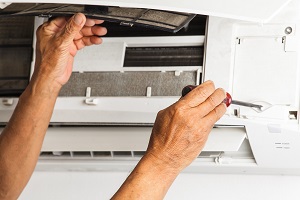There are different ways of cleaning fan coil components. Light cleaning can be done if the coil is less contaminated compared to heavy cleaning for coil heavily contaminated with dust and dirt. This article compare the results between using chemical solutions or vacuum cleaning for fan coil cleaning.
Vacuum Cleaning Method
Coils on most fan coil units can be cleaned by removing the motor and blower assemblies and brushing the air face between fins with a stiff brush followed by a thorough vacuuming.
The vacuum cleaning method is easier and safer as you do not need to worry about the negative effects from chemical. Vacuuming can help to get rid of solid debris and dust but the flip side of using a vacuum however is that it may not get rid of enduring tougher stains. It is not effective in extracting dirt, sticky fluid-like chemicals or bad foul odour from the fan coil. Moreover, there are certain areas where the vacuum cleaner can’t reach, especially in round corners or components that are deeply embedded.
If the coil is heavily contaminated with dust and dirt, using soft bristle brush or blowing low pressure compressed air on the fins is not effective. It necessitates the use of chemical solution.
Chemical Solution Cleaning
Most chemical solution can be used to clean the coils and they include acids, alkaline, solvent or detergent based coming in liquid or powder form. The coil cleaner is mixed and diluted with water to obtain the desired concentration. Most technicians mix and dilute coil cleaners in a standard pump sprayer, pressurize the sprayer, and apply the liquid to the coils. When the solution is applied on the coil surface there is a chemical reaction as foaming properties help float debris out of the coil body where it can be rinsed away.
Acid-based coil cleaners are very effective and will remove any material from coils — including the metal on the coils if you are not careful. While proving effective as a coil cleaner, the acid-based products come with a few hazards. Acids produce vapors that carry a strong acid smell which, in the right concentrations, can cause teary eyes and choking. It is also dangerous as it will dissolve just about anything it touches. Therefore, thorough rinsing is very important.
Alkaline-based coil cleaners are also very effective, fairly safe, and offer excellent cleaning results but they produce a mild odor while effectively removing foreign materials from the surface of the coils.
Solvents used as coil cleaners are very effective in removing grease but not heavy particulates and corrosion. It has a short dry time and limited rinsing. Most solvents are flammable and most give off strong smells and vapors. Solvent-based coil cleaners tend to work best in areas where a lot of water cannot be used for rinsing.
Detergent coil cleaners are usually slightly alkaline with foaming agents to speed the cleaning process. This works well in areas where there is buildup of grease and tar, but not for removing particulates and corrosion. It usually require thorough rinsing.
Usually an acid- or alkaline-based coil cleaner is used but where heavy grease or tar is present, a solvent- or detergent-based coil cleaner may be needed.
A clean coil is not necessarily bright. In all probability, the brighter the coil’s surfaces, the more metal you have just removed. Consistent use of products that result in bright coils can diminish the life of the coil, because they dissolve the outer surface of the metal.
In conclusion, if you want to clean a heavily contaminated aircon. vacuuming is not an effective method. Moreover,there are many areas which a vacuum cannot reach. the best approach is use a proper chemical solution which can help to remove stubborn stain and contamination which are stuck thoroughly as chemical residue from certain chemical may be harmful for the components with water thoroughly as chemical residue from certain chemicals may be harmful for the components. There are also certain brands of chemical solution in the market that are not harmful to the metal components but such chemical may be more costly.








